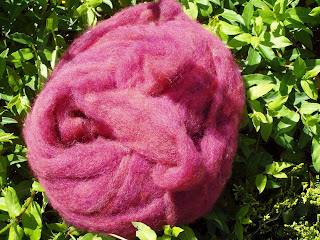 It's huge (that's my Lendrum behind it), with a 29" drive wheel (the Lendrum's is 18"). It doesn't have the versatility of the Lendrum, but it should help me spin fine-to-medium, smooth-to-slightly-slubby yarn extremely quickly. That's what it was designed to do -- these wheels were for women spinning for income, and there was quite a little industry producing them.
It's huge (that's my Lendrum behind it), with a 29" drive wheel (the Lendrum's is 18"). It doesn't have the versatility of the Lendrum, but it should help me spin fine-to-medium, smooth-to-slightly-slubby yarn extremely quickly. That's what it was designed to do -- these wheels were for women spinning for income, and there was quite a little industry producing them.I became intrigued by these wheels a while back, and started thinking about them more and more. There's an online discussion group for them, which just added fuel to the fire. A couple of months ago one turned up on Craigslist up in Edmond, but by the time I had noticed it, it had been sold -- to someone else in that group. You've got to move fast, I realized.
Many of the wheels that people find need a lot of rehabbing, which is not what I wanted. So I was really excited to see on Craigslist that looked good, was reasonably priced, and was only about half an hour away. I emailed the seller and made an appointment for the next morning; by lunch time it was in my living room.
It's in very good shape, considering. The seller had it for decor only; it had come from an antique show in Minnesota about 10 years ago. It has obviously seen a lot of use at one time (oil stains) but probably hadn't spun in decades.
There's some damage to the wheel rim, but nothing that will affect spinning:

And the footman is wonky; I'm still bending it in different ways to get it to the right height and to try and resolve a click:

The flyer assembly was the only real source of trouble. It looks great:

but the bobbin and flyer would barely turn independently due to decades of solidified gunk inside. I spent Monday evening cleaning the bobbin out with alcohol & q-tips, and polishing the flyer shaft with steel wool. I thought I had done a pretty good job, but it still jammed going back on:

Not good. If the bobbin doesn't rotate freely on the flyer, your yarn won't wind on. So I did some reading Monday night & Tuesday morning, and got a lot of helpful advice from the Ravelry CPW Lover's group, before I turned my attention to preparing for house guests. I picked up a few supplies on my way to get the kids after school, and Tuesday night I polished the shaft with a hand drill and some Turtle Wax car polishing compound, using the bobbin as a polishing tool. (CPW bobbins have metal bushings, so they can take this. Most don't, and couldn't.)
Then I reassembled the wheel, oiled everything with high-viscosity gun oil (another afternoon purchase) and ....

... started spinning. It's a blast! I haven't cleaned out the metal bits you see below the flyer, so I can't control the tension with any finesse. It's either too-light-to-spin or 20-mule-team, not much in between. So this yarn is hardly my best, or even my usual. But I foresee a lovely future with this wheel, turning the pile of fleeces in the garage into yarn.










































